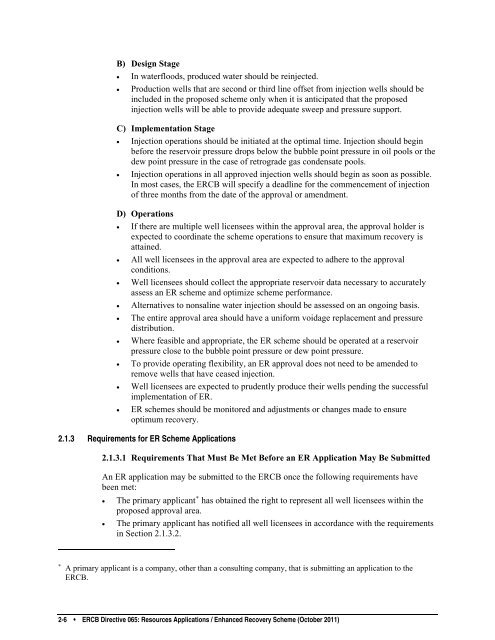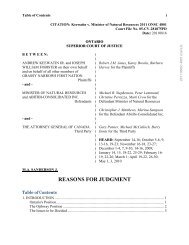Directive 065: Resources Applications for Oil and Gas Reservoirs ...
Directive 065: Resources Applications for Oil and Gas Reservoirs ...
Directive 065: Resources Applications for Oil and Gas Reservoirs ...
Create successful ePaper yourself
Turn your PDF publications into a flip-book with our unique Google optimized e-Paper software.
B) Design Stage<br />
• In waterfloods, produced water should be reinjected.<br />
• Production wells that are second or third line offset from injection wells should be<br />
included in the proposed scheme only when it is anticipated that the proposed<br />
injection wells will be able to provide adequate sweep <strong>and</strong> pressure support.<br />
C) Implementation Stage<br />
• Injection operations should be initiated at the optimal time. Injection should begin<br />
be<strong>for</strong>e the reservoir pressure drops below the bubble point pressure in oil pools or the<br />
dew point pressure in the case of retrograde gas condensate pools.<br />
• Injection operations in all approved injection wells should begin as soon as possible.<br />
In most cases, the ERCB will specify a deadline <strong>for</strong> the commencement of injection<br />
of three months from the date of the approval or amendment.<br />
D) Operations<br />
• If there are multiple well licensees within the approval area, the approval holder is<br />
expected to coordinate the scheme operations to ensure that maximum recovery is<br />
attained.<br />
• All well licensees in the approval area are expected to adhere to the approval<br />
conditions.<br />
• Well licensees should collect the appropriate reservoir data necessary to accurately<br />
assess an ER scheme <strong>and</strong> optimize scheme per<strong>for</strong>mance.<br />
• Alternatives to nonsaline water injection should be assessed on an ongoing basis.<br />
• The entire approval area should have a uni<strong>for</strong>m voidage replacement <strong>and</strong> pressure<br />
distribution.<br />
• Where feasible <strong>and</strong> appropriate, the ER scheme should be operated at a reservoir<br />
pressure close to the bubble point pressure or dew point pressure.<br />
• To provide operating flexibility, an ER approval does not need to be amended to<br />
remove wells that have ceased injection.<br />
• Well licensees are expected to prudently produce their wells pending the successful<br />
implementation of ER.<br />
• ER schemes should be monitored <strong>and</strong> adjustments or changes made to ensure<br />
optimum recovery.<br />
2.1.3 Requirements <strong>for</strong> ER Scheme <strong>Applications</strong><br />
2.1.3.1 Requirements That Must Be Met Be<strong>for</strong>e an ER Application May Be Submitted<br />
An ER application may be submitted to the ERCB once the following requirements have<br />
been met:<br />
• The primary applicant ∗ has obtained the right to represent all well licensees within the<br />
proposed approval area.<br />
• The primary applicant has notified all well licensees in accordance with the requirements<br />
in Section 2.1.3.2.<br />
∗<br />
A primary applicant is a company, other than a consulting company, that is submitting an application to the<br />
ERCB.<br />
2-6 • ERCB <strong>Directive</strong> <strong>065</strong>: <strong>Resources</strong> <strong>Applications</strong> / Enhanced Recovery Scheme (October 2011)
















